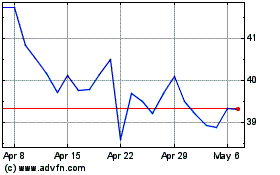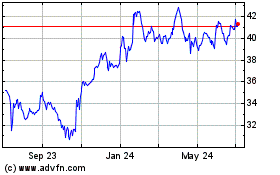By Sahil Patel
The internet may be steadily transforming the TV business, but
there is one day a year when viewers and advertisers still act like
almost nothing has changed: Super Bowl Sunday.
Fox Corp. charged up to $5.6 million for 30 seconds of TV ad
time during this year's Super Bowl, and said it was sold out in
late November.
It sought $300,000 to $400,000 for streaming-only ads during the
game, which took slightly longer to sell out, according to people
familiar with the matter. For example, sneaker brand Saucony bought
its streaming-only Super Bowl ad in December.
Fox sold streaming-only ads that will appear on its own sites
and apps, using time slots that go to local ads during the
traditional TV broadcast.
The differences largely reflect how marketers expect audiences
to watch when the San Francisco 49ers face the Kansas City Chiefs
on Sunday.
In the past decade, Super Bowl viewership in the U.S. on
traditional TV has routinely surpassed 100 million viewers a
minute.
But the number of those who watched it on a free live stream in
the last two years was much lower, based on data released by recent
game broadcasters CBS Corp. and Comcast Corp.'s NBC. Last year's
Super Bowl averaged 2.6 million live streaming viewers a minute,
according to CBS.
That was an increase from more than 2 million streaming viewers
a minute in 2018, the figure reported by NBC at the time, but still
far below the traditional TV audience.
Fox has told advertisers that this year's game will attract
millions of live streamers, according to a person familiar with the
matter. It will be available free on a number of sites and apps
owned by the network, the National Football League and Verizon
Communications Inc. -- similar to the arrangement last year, when
the game was carried by CBS.
The rise of streaming has changed how TV viewers watch
programming such as scripted and unscripted shows, which they
increasingly consume on services such as Netflix Inc. But telecasts
of live sports have proven more resistant to change, largely
because of the games' immediate nature and teams' passionate
followings. Even as the National Basketball Association's TV
ratings have declined this season -- a development the league
blames in part on player injuries -- the NFL's ratings have grown.
Meanwhile, Netflix last year said that U.S. viewership on its
service dropped 32% during the Super Bowl, compared with a typical
Sunday.
Better focus
Saucony bought a streaming-only ad in the Super Bowl to promote
a new biodegradable shoe.
Saucony made the buy partly because of the growth in streaming
viewing, including among younger viewers, said Don Lane, chief
marketing officer of Saucony, which is owned by Wolverine World
Wide Inc.
Streaming video viewers tend to be more engaged with what is
playing on the screen than their linear TV counterparts, Mr. Lane
added, citing the experience of a previous streaming ad campaign
that Saucony ran in November and conversations the brand has had
with Fox.
"People who are tuning in through a streaming service are paying
more attention and less distracted than the broader audience," he
said. "We might be sacrificing reach by not being on the broadcast,
but I think where we gain is in getting impact."
But networks still sell Super Bowl ads primarily as one big
package, and every national TV ad during the Super Bowl on Fox will
also play in the live stream.
With the game's immense scale and high ad prices, broadcasters
don't feel pressure to split up inventory based on how people are
choosing to view the game, said Mark Zagorski, chief executive
officer of Telaria Inc., which sells internet-connected TV ads on
behalf of video publishers and recently agreed to merge with
Rubicon Project Inc., another ad tech company servicing
publishers.
"The big game is still the big game," Mr. Zagorski said.
That doesn't mean they want outsiders selling Super Bowl ads --
even in streaming viewing, where other companies would ordinarily
have opportunities to serve ads into programming.
Online TV services such as Hulu Live TV, YouTube TV, Sling TV
and FuboTV don't have any in-game Super Bowl ad inventory to sell,
people familiar with the matter said.
"It's pretty typical for the Super Bowl: The networks lock it
down pretty tightly," Mr. Zagorski said. "They don't want third
parties selling against it."
The exception is Verizon, which can sell Super Bowl ads within
its mobile live stream as a result of a multiyear rights and
sponsorship deal. Like Fox, its streaming-only Super Bowl ad
inventory replaces local Fox TV stations' ad time.
Verizon still has inventory available, people familiar with the
situation said.
One key difference between Fox's digital-only ads and Verizon's
digital ads is that Fox will serve the same ad to everyone
live-streaming the game on its websites and apps, while Verizon
plans to use its digital ad technology to serve different ads to
different viewers, which opens up more ad inventory for Verizon to
sell, people familiar with the situation said.
Fox Corp. and Wall Street Journal parent News Corp share common
ownership.
Perhaps unsurprisingly, the Super Bowl has provided a boost to
ad prices for streaming programming before and after the game --
similar to its impact on linear TV programming.
Streaming-only ads can cost between $200,000 to $300,000 during
the pregame window, according to a person familiar with the matter.
A linear TV buy within the same window could cost anywhere from 2
1/2 to 10 times more, this person said.
Write to Sahil Patel at sahil.patel@wsj.com
(END) Dow Jones Newswires
January 31, 2020 13:51 ET (18:51 GMT)
Copyright (c) 2020 Dow Jones & Company, Inc.
Verizon Communications (NYSE:VZ)
Historical Stock Chart
From Mar 2024 to Apr 2024

Verizon Communications (NYSE:VZ)
Historical Stock Chart
From Apr 2023 to Apr 2024
